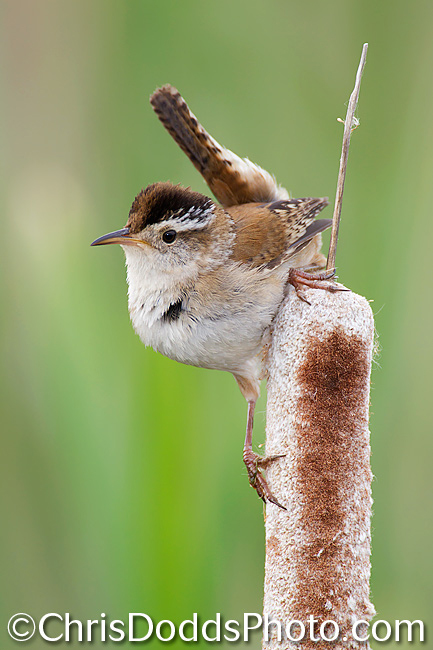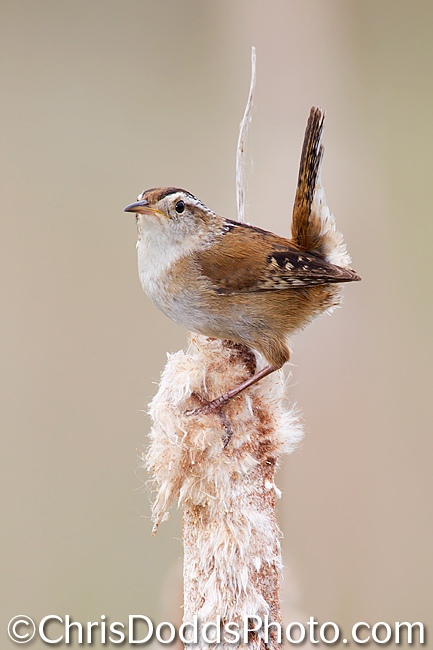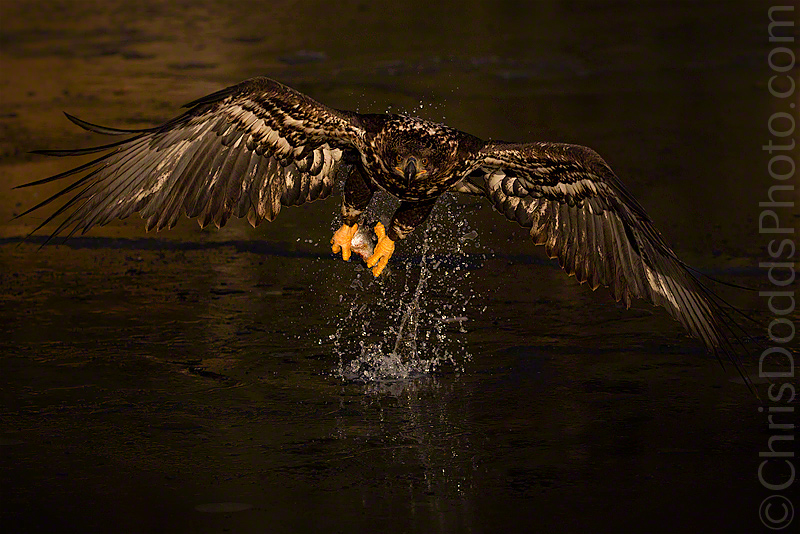 Marsh Wren vertical portrait (Cistothorus palustris, Troglodyte des marais, MAWR) Bois de I'Ile Bizard Nature Park, L'ile Bizard, Montreal, Quebec, Canada. Image Copyright ©Christopher Dodds www.chrisdoddsphoto.com All Rights Reserved. Canon EOS-1D MKIV, 500mm F4L IS USM and 2X II Tele-extender. ISO 800, 1/320s F9. Canon 580 EX II Flash in manual mode. Tripod and Wimberley Head II. CLICK HERE TO PURCHASE A PRINT or LICENSE IMAGE FOR PUBLICATION.
Marsh Wren vertical portrait (Cistothorus palustris, Troglodyte des marais, MAWR) Bois de I'Ile Bizard Nature Park, L'ile Bizard, Montreal, Quebec, Canada. Image Copyright ©Christopher Dodds www.chrisdoddsphoto.com All Rights Reserved. Canon EOS-1D MKIV, 500mm F4L IS USM and 2X II Tele-extender. ISO 800, 1/320s F9. Canon 580 EX II Flash in manual mode. Tripod and Wimberley Head II. CLICK HERE TO PURCHASE A PRINT or LICENSE IMAGE FOR PUBLICATION.
 Marsh Wren vertical portrait on beige (Cistothorus palustris, Troglodyte des marais, MAWR) Bois de I'Ile Bizard Nature Park, L'ile Bizard, Montreal, Quebec, Canada. Image Copyright ©Christopher Dodds www.chrisdoddsphoto.com All Rights Reserved. Canon EOS-1D MKIV, 500mm F4L IS USM and 2X II Tele-extender. ISO 800, 1/320s F9. Canon 580 EX II Flash in manual mode. Tripod and Wimberley Head II. CLICK HERE TO PURCHASE A PRINT or LICENSE IMAGE FOR PUBLICATION.
Marsh Wren vertical portrait on beige (Cistothorus palustris, Troglodyte des marais, MAWR) Bois de I'Ile Bizard Nature Park, L'ile Bizard, Montreal, Quebec, Canada. Image Copyright ©Christopher Dodds www.chrisdoddsphoto.com All Rights Reserved. Canon EOS-1D MKIV, 500mm F4L IS USM and 2X II Tele-extender. ISO 800, 1/320s F9. Canon 580 EX II Flash in manual mode. Tripod and Wimberley Head II. CLICK HERE TO PURCHASE A PRINT or LICENSE IMAGE FOR PUBLICATION.
I enjoyed a great afternoon at Bois de I'Ile Bizard Nature Park, L'ile Bizard (Montreal) with clients/friends Tuma Young and Nick Honig from Halifax, NS (both of whom I’ll be seeing them again very soon at my workshop on Bonaventure Island). The star performer yesterday was surly this Marsh Wren that was building it’s nest right along the boardwalk trail.
PRO TIP: Silky Smooth Bokehlicious backgrounds for Birds
Whenever I find a co-operative subject in a place where there could potentially be a distracting, cluttered background (like a marsh full of reeds and bulrushes), I almost always immediately slap a 2X tele-converter onto my 500mm lens. I do this to take advantage of a narrower field of view (less distracting elements included in the frame) and the smaller depth of field that narrows as the focal length increases; creating smooth out-of-focus backgrounds (also known as bokeh).
Canon announces firmware update Version 2.0.7 for the EOS 5D Mark II DSLR.
his firmware update (Version 2.0.7) incorporates the following improvements and fixes.
- Fixes a phenomenon in which the aperture exhibits abnormal movement when shooting movies in manual exposure mode and Aperture Priority AE (Av mode) using some Canon lenses (such as macro lenses).
- Fixes a phenomenon in which the exposure level shown in the LCD panel differs from what is shown in the viewfinder when shooting still images in manual exposure mode.
- Fixes a phenomenon in which the Wireless File Transmitter (WFT-E4 or WFT-E4 II) may not automatically power off when used for FTP transfers.
These phenomena only occur with the Version 2.0.4 and Version 2.0.3 firmware. The Version 2.0.7 firmware being released this time is for cameras with firmware up to Version 2.0.4. If the camera's firmware is already Version 2.0.7, it is not necessary to update the firmware.
To find out the exact download instructions and to download EOS 5D Mark II firmware Version 2.0.7 please click here. Please note that before downloading firmware Version 2.0.7 you should read the entire contents of the page linked to above.
For all current Canon EOS firmware downloads please click here.
Marsh Wren (Cistothorus palustris, Troglodyte des marais, MAWR)
The Marsh Wren (Cistothorus palustris, Troglodyte des marais, MAWR) is a small North American songbird of the wren family. It is sometimes called Long-billed Marsh Wren to distinguish it from the Sedge Wren, also known as Short-billed Marsh Wren. The Marsh Wren is a secretive bird; even when singing the territorial male remains well hidden, briefly climbing a cattail for a look at an intruder. Males destroy eggs and nestlings of neighboring birds. They will even attack their own eggs if the female is removed from the nest. This behavior reduces competition for food in their area.
Adults have brown upper-parts with a light brown belly and flanks and a white throat and breast. The back is black with white stripes. They have a dark cap with a white line over the eyes and a short thin bill. Bewick's Wren is similar but has unstreaked back. Sedge Wren has less distinct supercilium and streaked crown.
The male's song is a loud gurgle used to declare ownership of territory; western males have a more varied repertoire. Learning continues throughout their adult life; it has been shown they will imitate songs presented to them on a tape recording or by a live tudor.
Their breeding habitat is marshes with tall vegetation such as cattails across North America. In the western United States, some birds are permanent residents. Other birds migrate to marshes and salt marshes in the southern United States and Mexico.
These birds forage actively in vegetation, sometimes flying up to catch insects in flight. They mainly eat insects, also spiders and snails.
The nest is an oval lump attached to marsh vegetation, entered from the side. The clutch is normally 4–6 eggs, though the number can range from 3–10. The male builds many unused nests in his territory; he may puncture the eggs of other birds nesting nearby.
This bird is still common, although its numbers have declined with the loss of suitable wetland habitat. Wholesale draining of marshes will lead to local extinction. Still, this species is widespread enough not to qualify as threatened according to the IUCN.
 Great Grey Owl (Strix nebulosa, Chouette Lapone, GGOW) ©Christopher Dodds Sony Alpha a9 Mirrorless Camera & Sony FE 400 f/2.8 GM OSS ISO 3,200, F5.6 @ 1/3,200s Manual Exposure mode and Sony's eye AF. Join me for my winter owl workshops this January/February to learn More CLICK HERE.
Great Grey Owl (Strix nebulosa, Chouette Lapone, GGOW) ©Christopher Dodds Sony Alpha a9 Mirrorless Camera & Sony FE 400 f/2.8 GM OSS ISO 3,200, F5.6 @ 1/3,200s Manual Exposure mode and Sony's eye AF. Join me for my winter owl workshops this January/February to learn More CLICK HERE.

